Add new Service Catalog item
For adding new service item just click on Add Service
item button above the table. Adding new service item is done in six
steps.
First step – Start
Service Item can be created in two ways. Using new, empty
template or based on a copy of an existing SCI.
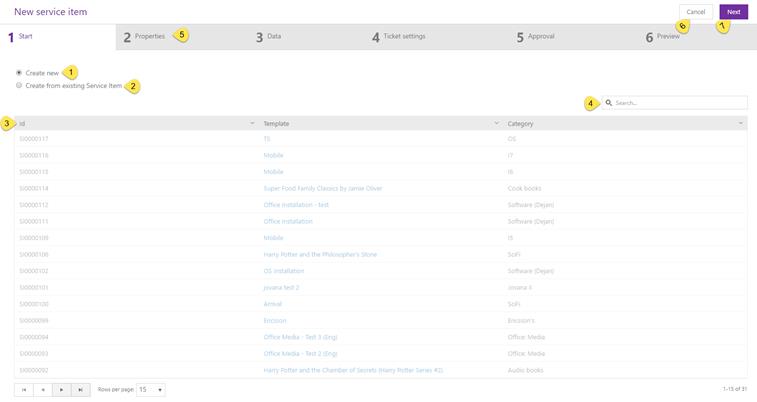
Step 1 - Start
1.
Create new – Select this radio button in case you want to create new
service item and click Next
(7) button or Properties (5) tab to proceed to
the next step.
2.
Create from existing Service Item – Select this radio button in case you
want to create service item from existing items. When you select this button
list of all existing service items (3) enables and you can search list using
search box (4).
3.
List of all existing service items – Initially this list is disabled, but
in case you select Create from existing Service Item this list is
enabled and you can search service item which you want to use for
creating new one.
4.
Search – search feature in this section allows you to search existing
Service Item from the list if you select Create from existing Service
Item. You enter keyword related to the Service Item that you want to find.
Search box here comes with the autocomplete feature. As soon as you types the
keyword in the search box, the auto complete box gets filled with the search
result. You can select desired Service Item from that box. System searches for
the keyword in following columns: Id, name, category, currency, status.
Use Cancel (6) button if you want to cancel
adding new service item.
Use Next (7) button to proceed to the next
step.
Second step – Properties
In this step you
define all SCI properties. There is a set of default properties that are same
for all SCI, those could not be changed, and two segment for adding custom
fields (Specific
information and Order information).
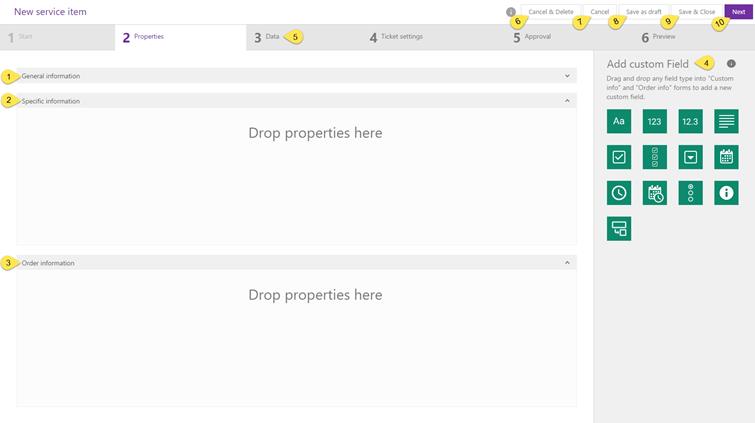
Service item properties
1. General information:
List of default properties that each SI has and which are same for
all SI categories. In this step this list is disabled, you edit the information
in the next step, Data (5).
2. Specific
information: List of fields that will additionally describe the
service item. You define property field types and field headers. Data will be
filled by the SCI creator later in the next step, Data (5), of the creation of the SCI.
3. Order information:
List of custom fields the end user must fill in order to make a valid Service
Order. You define property field types and field headers.
Adding specific and
order information are done in the same way. Add fields here working with drag
and drop principle and are similar to add fields or properties to other
entities, see Custom Entity forms /
Property editor.
When you create property fields you can create field
headers in different languages.
All custom fields, respectively properties can be
deleted. Click the field and select Delete in popup.
When all fields are created, use Next (10) button or click on Data (5) tab to proceed
next step.
Use Save
as draft (8) button to save
service item as draft. Form stays open and service item will be saved with Draft status and
all properties and values you set in this steps will be saved. In case that the
service item has status different from Draft, Save as draft button is called Save.
Use Save
& Close (9) button to save
service item and close form. Form closed and service item will be saved with
current
status and all properties and values you set in this steps will be saved.
Use Cancel (7) button for canceling form. Form
will be closed and service item will be saved with current status but properties
and values will not be saved.
Use Cancel & Delete (6) button to cancel
form and delete service item.
Third step – Data
In this step you fill General and Specific information
of the Service Catalog
Item. Data shall compose a complete description of the Service Catalog
Item that is offered to customers.
Managing languages
When you input data in fields that are defined as
multilingual (Name, Short description, Long description
and fields in Specific
information fields defined as translatable) following rules are in
use:
When SCI is saved first time (create SCI from new empty
template) all data values are saved in NSP Standard Language. If Agent has not
selected the standard language when creating the Service Catalog Item a symbol  is displayed at the top of form to
warn/inform user that data will be saved in other language than Agent has currently
selected.
is displayed at the top of form to
warn/inform user that data will be saved in other language than Agent has currently
selected.
When Agent edit a Service Catalog Item all data are saved in
language that Agent has currently selected. Correct working process to create a
SCI in several languages is:
1. Select NSP Standard
Language in your user profile Settings.
2. Create the Service Catalog
Item in NSP
Standard Language (all steps and Save).
3. Change language to
language 2.
4. Edit Service Catalog
Item in language 2.
5. Repeat 3-4 for all other
languages in use.
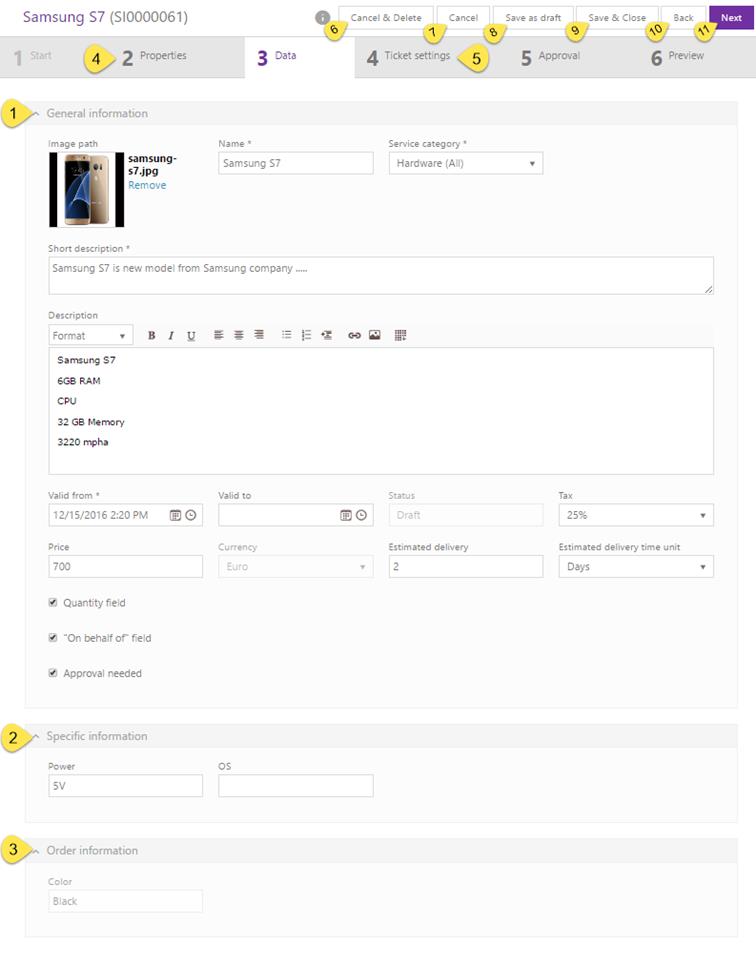
General
information contains list of all default properties that each SCI
has and which are same for all categories.
In following table you can find list of default SCI
properties:
|
Field |
Description |
|
Image path |
Upload image which will represent
SCI. |
|
Name |
Text field. Name of SCI. Saved as a user defined
language dependent value, could have different value for different
languages. |
|
Service category |
Dropdown field. You can choose from
Categories defined in
Service
Catalog. |
|
Short description |
Text field. Name and
Short
description are displayed on Service
Catalog home page. Saved as a user defined language
dependent value, could have different value for different
languages. |
|
Description |
Text area field. There are formatting tools to
format text, and you can add images and links. Saved as a user defined
language dependent value, could have different value for different
languages. |
|
Valid from |
Date and time field. Choose date from which
SCI should be valid (Published). Time is set to
current time as default when you create a new SCI. |
|
Valid to |
Date and time field. Choose date which SCI
shall no longer be valid (Archived). You don´t have
to define this time. If it is not set the SCI will be valid until it is
manually archived. |
|
Status |
Current status of SCI. Default value for a new
item is normally Draft. More information, see Service Item
default lifecycle. |
|
Tax |
Dropdown field. You can choose from taxes defined
in NSP. Must not be defined, if not selected no tax is added to the
Price. |
|
Price |
Decimal field. Insert SCI price in selected Currency. |
|
Currency |
This field defined standard currency and cannot be
edited. SCI Price shall be defined in this
currency. |
|
Estimated delivery |
Number field. Insert number, forms together with
Estimated delivery time unit estimated delivery time. |
|
Estimated delivery time unit |
Dropdown field. You can choose Minutes, Hours,
Days, Month and Years. Forms together with numeric value Estimated
delivery estimated delivery time. |
|
Quantity field |
Checkbox field. Select this field if you want to
allow ordering larger quantities (>1) of this item. A field for
quantity is added in Service Catalog where Requester
must input number when ordering SCI. |
|
“On behalf of” field |
Checkbox field. Select this field if you want to
allow “On behalf
of” ordering for this item. Person creating the order and
the Requester can then be different
users. |
|
Approval needed |
Checkbox field. Select this field if selected authorized
Approver must approve the order before it enters the delivery
process. |
|
Hide price information |
Checkbox field. Enable this field if provided
service is free of charge for the requester. No information concerning
price, tax or currency is displayed for the service
item. |
In this step you also fill values for Specific
information (2) which you defined in previous step.
Ordering information (3) shows properties
for ordering which you defined in pervious step, but you cannot edit. Ordering
segment in this step is disabled, data should be input by Requester when
ordering SCI.
Use
Next (11) button or click on Ticket settings
(5) tab to proceed
the next step.
Use Back (10) button or click
on Properties
(4) tab to go to pervious step.
Use
Save as draft (8) button to save
service item as draft. Form stays open and service item will be saved with Draft status and
all properties and values you set in this and pervious steps will be saved. In
case that the service item has status different from Draft, Save as draft
button is called Save.
Use
Save & Close (9) button to save
service item and close form. Form closed and service item will be saved with
current
status and all properties and values you set in this steps will be saved.
Use Cancel (7) button for
canceling form. Form closed and service item will be saved with current status
and all properties from pervious step will be saved but properties and values
from this step will not be saved.
Use Cancel & Delete (6) button to cancel
form and delete service item.
Fourth step – Ticket settings
In this step you define ticket settings for Service
Order ticket. After ordering and approve, if specified, a ticket is created for
handling the delivery.
In this step you define Ticket Subject and default Assignee (Agent or Group).

Ticket settings
Subject (1) define ticket subject, see
below.
Default assignee (2) define assignee of created
ticket. This field has auto-complete feature, start input name of group or
agent, dropdown is shown with search result. Select assignee in dropdown. If you
click the  symbol a browse
form is opened. You can search for a Group or an Agent in NSP which will be assignee of the
created ticket.
symbol a browse
form is opened. You can search for a Group or an Agent in NSP which will be assignee of the
created ticket.
Use
Next (10) button or click on Approval (3) tab to proceed
the next step.
Use Back (9) button or click
on Data (4) tab to go to
pervious step.
Use
Save as draft (7) button to save
service item as draft. Form stays open and service item will be saved with Draft status and
all properties and values you set in this and pervious steps will be saved. In
case that the service item has status different from Draft, Save as draft
button is called Save.
Use
Save & Close (8) button to save
service item and close form. Form closed and service item will be saved with
current
status and all properties and values you set in this steps will be saved.
Use Cancel (6) button for
canceling form. Form closed and service item will be saved with current status and
all properties from pervious step will be saved but properties and values from
this step will not be saved.
Use Cancel & Delete (5) button to cancel
form and delete service item.
Ticket Subject
For Ticket Subject customization a template
form is used. Click on  button and following form appears:
button and following form appears:
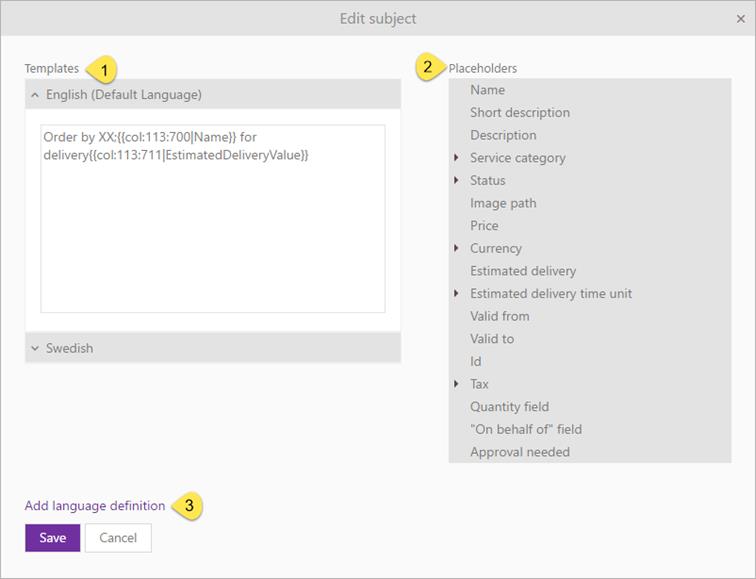
Edit Ticket Subject
Fields in Edit Subject form:
1. Templates: This box
is used to define the Ticket Subject text. Text is built of a
combination of plain text and Placeholder values (variables collected
from the SCI data).
2. Placeholders:
Consists a list of all properties referred to Service Catalog Item. You can
click the placeholder to include it in the template along with other text. These
placeholders will be replaced with the actual value when the ticket is created.
3. Add language
definition: Select the language from the list to create Template
for the specific language. You can select different language and then define
Template for the selected language in respective textbox. Repeat the procedure
for next language needed, and so on. Ticket will be created in end user (Requester) default
language.
Fifth step – Approval
This step is used for selecting Service Order approval.
If you select Approve
needed checkbox in Data step, than in this step Default approver
field is enabled and you can choose which Agent from NSP should approve service
order. In case that Approver needed is not selected in the
third step, than this option is disabled and you got a notification: Approval function is not
activated on "Data" tab.
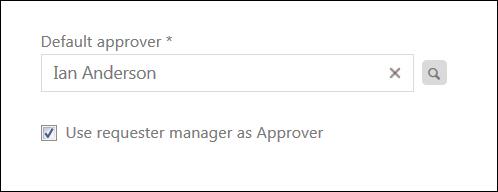
Approval
tab
Default approver define user with permission to
approve the order. This field has auto-complete feature, start input name of
agent, and dropdown is shown with search result. Select approver in dropdown. If
you click the  symbol a
browse form is opened. You can search for an Agent in NSP which will be approver of the
order.
symbol a
browse form is opened. You can search for an Agent in NSP which will be approver of the
order.
Below the Default approver field there could be a
checkbox Use Requester
manager as Approver. A system setting controls if this checkbox
should be available. If you enable the checkbox the service item will have a
dynamic approver. System is searching for requester´s manager and select the
manager as approver of the service order. If there is no manager defined system
use Default
approver as approver of the service order.
The system setting to activate the
dynamic approver (Use
Requester manager as Approver) feature is set by a database
script. Contact NSP Support if you need the script (nspsupport@nilex.se).
AdManagerUserId is a standard field on
Base Person entity for dynamically approve of service orders. If you have used
other user defined field for this before, contact NSP Support if you need script
to transfer values from old field to new standard field. To use the new field as
dynamic approver you also must run a script to change the settings in database.
This script you also can get from NSP Support.
Use
Next button or click on Preview tab to
proceed the next step.
Use Back button or click on Ticket settings tab
to go to pervious step.
Use
Save as draft button to save service item as draft. Form stays
open and service item will be saved with Draft status and all properties and values
you set in this and pervious steps will be saved. In case that the service item
has status different from Draft, Save as draft button is called Save.
Use
Save & Close button to save service item and close form. Form
closed and service item will be saved with current status and all properties and
values you set in this steps will be saved.
Use Cancel button for canceling form. Form
closed and service item will be saved with current status and all properties from
pervious step will be saved but properties and values from this step will not be
saved.
Use Cancel & Delete button to cancel form
and delete service item.
Sixth step – Preview
This step is used for final preview of the Service
Catalog Item. All information you customize in pervious steps will be appear
here. If you are satisfied with service item preview click Save as Pending
Published and service item will be saved with Pending Publish
status. Status will automatically be changed to Published when time for Valid from has been
reached.
In case that the service item has status different from
Draft, Save as Pending
Published button is called Save and service item will be saved in
current status.
In case you want to continue editing service item use
Back button
or click on pervious
tab to back on pervious step to change and adapt desired
information.
Use Cancel button for canceling form. Form
closed and service item will be saved with current status and all properties from
pervious step will be saved but properties and values from this step will not be
saved.
Use Cancel & Delete button to cancel form
and delete service item.


 is displayed at the top of form to
warn/inform user that data will be saved in other language than
is displayed at the top of form to
warn/inform user that data will be saved in other language than 

 symbol a browse
form is opened. You can search for a
symbol a browse
form is opened. You can search for a  button and following form appears:
button and following form appears:

 symbol a
browse form is opened. You can search for an
symbol a
browse form is opened. You can search for an